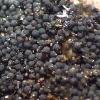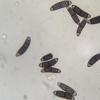
21-03-2016 23:03
Lepista ZacariasHi everyone,This fungus was found at the base of a

21-03-2016 19:56
 Angel Pintos
Angel Pintos
Could be Dentrostilbella? It appeared incubating

21-03-2016 09:30
Eduard OsieckDoes anyone has an idea what this could be? Found

20-03-2016 22:07
Salvador TelloHola.He cogido estos hongos creciendo sobre madera

20-03-2016 20:03
Adam PolhorskýHello, one more asco for todayGrowing in groups/cl
Small hairy bolls
Lepista Zacarias,
21-03-2016 23:03
This fungus was found at the base of a deciduous living tree. Ascoma formed by hairy round bolls. No hymenium was observed, only spores seeming like those of Hysterium with the following dimension:
(25.6) 28.3 - 34.9 (36.6) × (6.9) 7.6 - 9.1 (9.3) µm
Q = (3.2) 3.5 - 4.2 (4.7) ; N = 29
Me = 31.7 × 8.2 µm ; Qe = 3.9.
Abundant septate hyphae and setae.
Any hint about it?
Thanks in advance,
zaca
Andrew N. Miller,
21-03-2016 23:13

Re : Small hairy bolls
Chaetosphaerella phaeostroma
Andy
Andy
Lepista Zacarias,
21-03-2016 23:19
Re : Small hairy bolls
Thanks, Andrew, for your prompt reply.
I had seen this fungus once before, but didn't recognize its features
Best regards,
zaca
I had seen this fungus once before, but didn't recognize its features
Best regards,
zaca





